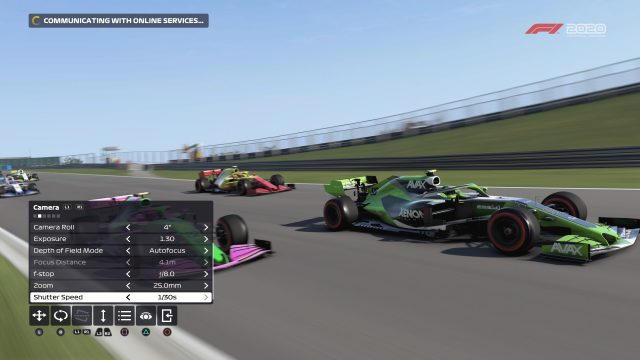
Over the past few years Codemasters have been slowly refining the F1 games, adding the occasional new feature such as last year’s F2 options, and tweaking an already successful formula to make it even more appealing and playable.
I started to wonder what more they could do. Sure they could add something like a fully-fledged livery editor like the one in Gran Turismo, or a more robust player creator like pretty much every EA Sports game you can find, but theyd just be cosmetic tweaks. The series had hit its peak last year, or so I thought. Codemasters clearly disagreed, and have added a range of new elements into the game which has made one of the best ever F1 games even better.
The most obvious and well-advertised feature is the My Team option. For the first time in a Codemasters F1 game you can now be the 11th team on the grid, creating your own team name, livery, colour scheme and logo. You’ll start off by recruiting an up and coming F2 driver into your team, and picking an engine supplier and initial sponsor. From day 1 there’s some finance balancing to be done, as firing up a Mercedes engine in the back of your car will cost you more than the slower Honda, for example. A bigger sponsor might offset that cost, but they’ll also expect more, and if you’ve got the difficulty dialed in right you’ll be fighting for 14th for some time before hoping for a podium. If you’re battling for the lead from the first race, despite your car being the worst on the grid, then you’re better than you think… get that difficulty turned up!
Over time you’ll upgrade your car in the same way as you used to in the career mode, and earn resource points in the same way you used to in career mode… in fact, unless you want to specifically race for an existing team (which is possible if you want to drag Williams back to the front, for example) the chances are My Team will eclipse the career mode. Within your own team though you’ll get opportunities to recruit better drivers over time, those with a better reputation or better stats that should help your push to the front. They’ll have demands that extend beyond just a fat pay cheque though; some will want your headquarters to have been upgraded to provide them with better facilities, or a better aerodynamics department. Don’t expect to be signing Hamilton half way through your first season!
Another big new addition is that of the Paddock Pass, essentially a Battle Pass with wheels. You get daily, weekly and season-long challenges to complete which earn you various rewards. If you have the Paddock Points to buy a VIP pass you get even more kit as you level up; if you’ve ever played a game with a Battle Pass you’ll know the score, but it was new to me and took a few moments to get my head round. I can see why people wouldn’t like this, especially if you didn’t buy the edition that comes with enough coins to buy a VIP pass from the start, but I’m finding it’s pushing me into trying things I wouldn’t normally do, such as time trials on certain tracks, or spending more time in the practice sessions during a race weekend.

When it comes to the on-track racing, one big change has made a massive difference to the tactics you can use on track. While last year the ERS system was a bit tough to understand (the electrical energy that can be applied to the engine to give you a time-limited speed boost), this year it’s far more akin to what a real driver would use. If you’ve seen the recent end-of-race heroics by Lando Norris in the two Austrian GPs, you’ll have heard his engineer talking about pushing the overtake button, even when there’s nobody to overtake. That’s the ERS, a button on the wheel that’s basically a short boost. The battery only has so much charge, which can be slowly refilled by simply braking or being off-throttle, and you can only use it for a set amount over the course of a lap. As such deciding when to use it, and how much, is a big deal. Do you use it to defend your position down the straight, or save it up to try and nab the place back immediately afterwards, hoping that the other driver used all of theirs up getting past you? Do you save it all over the first few laps so you’ve got a full battery to unleash at the end when other people might have worn tyres and an empty battery? It’s a whole new strategic choice, and makes the racing incredible.
Elsewhere there’s the usual livery update, with the new Williams livery in-place already. The black Mercedes still isn’t here, but I’m sure that won’t take long, it was quite last-minute after all. The cars feel more stable too, with the impossible Spanish chicane now driveable, and a few curbs have been tweaked to prevent you from spinning every time your car looks at them in the wrong way. Everything just feels tighter, and works incredible with a controller as well as a wheel.
It’s a shame, then, that there’s still some stability issues that crop up from time to time. Blue screen crashes on the PS4 still happen from time to time, and the network connectivity forces me to restart the game every now and then. It’s frustrating, especially as F1 2020 is so damn good you just want to play more, and more, and more. These little issues really jolt you out of the game.
But you can’t get away from the fact that this is, in my opinion, the best F1 game that’s ever been made. Sure, games like Geoff Crammond’s Grand Prix 2 was insane for its time, but on the merits and playability, as well as the features on offer, you’re not going to find a better F1 game anywhere else. It’s even good enough to recommend even if you’ve already got F1 2019, and that’s saying something.
Reviewed on PS4


Leave a Reply